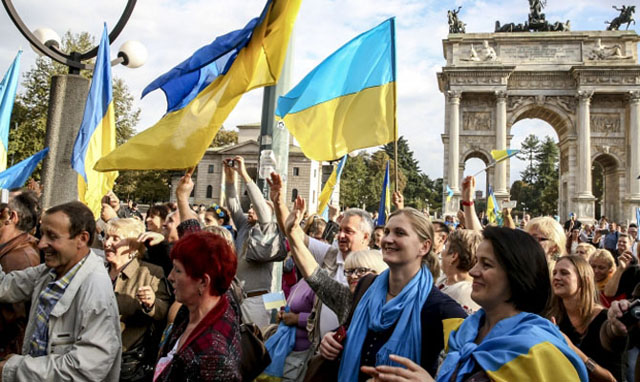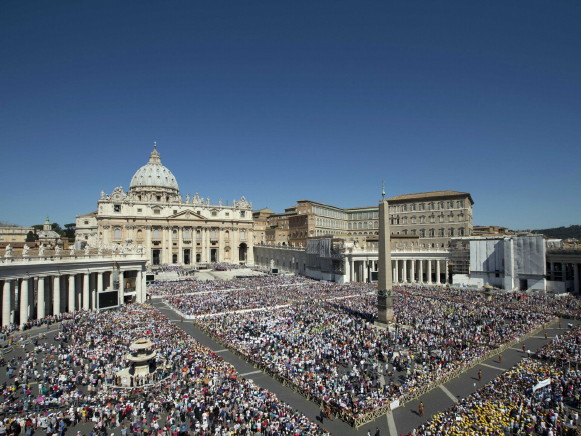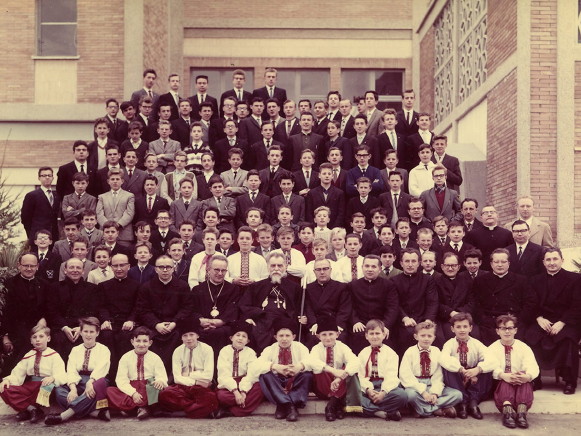Italy
Italy. A country (2020 pop 60,317,116) in southern Europe occupying the Apennine Peninsula and the islands of Sicily and Sardinia. It has an area of 301,277 sq km. Individual Italian states freed themselves from foreign rule beginning in the early Middle Ages, but Italy did not become a united kingdom until the mid-19th century. Since 1871 Rome has been its capital. A Fascist dictatorship between 1922 and 1945, Italy became a republic in 1946.
In the 12th and 13th centuries AD, Italian merchants appeared in Kyiv, and from the 12th to the 15th century, Venice, Genoa, and Pisa had commercial relations with the lands of the Crimea and southern Ukraine. Genoa and Venice established trading colonies on the northern Pontic Sea coast and the Sea of Azov coast and in the Crimea—Kaffa (Teodosiia), which even had its own bishopric, Soldaia (Sudak), Cembalo (Balaklava), Tana (Oziv), Bosporo (Kerch), Moncastro (Bilhorod-Dnistrovskyi), Matrega (Tmutorokan), Copa, Mapa, and Bata. From there, Italian corporations and individual merchants engaged in transit trade with the lands of Ukraine, Muscovy, Poland, Caucasia, Persia, India, and China. To obtain and maintain these colonies on the Black Sea and the Sea of Azov, Genoa and Venice waged war with each other and with the Crimean Tatars. The strongest center was Genoese-controlled Kaffa; before it was razed by the Turks in 1475, a thriving international market in slaves taken during Tatar raids into Ukraine and Caucasia operated there.
Relations between Italy and Rus’ date from the 10th century onward, when various popes sent legations to the princes of Kyiv and Galicia-Volhynia to negotiate a religious union or (later) an anti-Mongol coalition or both (see, eg, Danylo Romanovych and Church Union of Florence and Rome).
International trade routes between Europe and the Orient passed through Ukraine. In the 15th century, Italian merchants and artisans began settling in Lviv and other Western Ukrainian towns under Polish rule. There they specialized in trade and banking, opened schools of commerce, and introduced the ideas of humanism and the Renaissance. Italian craftsmen, architects, and painters built and embellished churches and palaces; eg, the Dormition Church in Lviv (by Petrus Italus from Lugano and Paolo Romanus), the Korniakt building (by Pietro di Barbone and Paolo Romanus), the Golden Rose Synagogue (by the Italian known as Pavlo Shchaslyvy), and the Black Building (by the Italian known as Petro Krasovsky) in Lviv. In Transcarpathia, as well, Italian influence is apparent in the architecture and frescoes of the rotunda in the village of Horiany, one of the many villages owned, together with Uzhhorod, between 1322 and 1691 by the Italian Drughet family, which founded Uzhhorod College. During the Renaissance individual Ukrainians studied in Italy and brought Italian ideas, literature, and culture back with them to Ukraine. One of them, Yurii Drohobych, became a professor and rector at Bologna University.
Italian-Ukrainian political relations did not exist in Ukraine under Polish rule until the Cossack period. In 1646 the Venetian emissary Alberto Vimina visited Hetman Bohdan Khmelnytsky in Chyhyryn to try to persuade him to join a military coalition against Turkey. Vimina published an account of the Cossack-Polish War in Venice in 1671.
There was significant Italian influence on Ukrainian literature, painting, architecture, and music in the baroque, rococo, and classicist periods. Such architects as S. Bracci, Bartolomeo Francesco Rastrelli, A. Rinaldi, and Giacomo Quarenghi built palaces and churches in Kyiv, Baturyn, Kozelets, and elsewhere in central Ukraine. At the same time Ukrainian artists and composers studied in Italy; eg, Antin Losenko, Ivan P. Martos, O. Biliavsky, V. Bereza, Dmytro Bortniansky, and Maksym Berezovsky. Many other Ukrainians visited Italy in the 17th and 18th centuries; some left accounts of their travels; eg, Hryhorii Skybynsky, Hieromonach T. Kaplonsky, Vasyl Hryhorovych-Barsky, and Teofan Prokopovych, who studied in Rome (1699–1701). Apparently, Hryhorii Skovoroda also visited Italy.
Around the time of the Church Union of Berestia (1596), close ties existed between the Ukrainian church and the Vatican, and religious representatives were exchanged. Soon after, a permanent presence of Ukrainian and Belarusian Uniate clergy was established at the Vatican in Rome, and it has lasted to this day.
In the 1820s and 1830s the Italian duke Charles of Bourbon-Parma resided in Vienna; there he became acquainted with the Ukrainian Greek Catholic priests at Saint Barbara's Church and became such an enthusiast of the Eastern rite that he built a Greek Catholic church at his home in Lucca. Three Transcarpathian priests—the writers Mykhailo Luchkai and later the brothers A. and O. Labants—stayed as guests there several years. In the 1840s and 1850s Rev Ipolyt Volodymyr Terletsky tried to influence the Vatican’s policies concerning Poland and Ukraine. Throughout the 19th century, Ukrainians from Galicia and Bukovyna in the Austrian imperial army were posted on the territory of northern Italy and took part in battles against the Italians. Their experiences are portrayed in the Romantic works of Antin Mohylnytsky, Mykola Ustyianovych, and particularly Yurii Fedkovych. In the second half of the 19th century, such Ukrainian writers and poets as Panteleimon Kulish, Nikolai Gogol, Marko Vovchok, Lesia Ukrainka, Borys Hrinchenko, and Mykhailo Kotsiubynsky visited Italy; their sojourns there are reflected in their works. Ukrainian painters of the 19th century also studied in or visited Italy; eg, Mykola Ge, Ilia Repin, P. Boryspolets (d 1880 in Rome), Rafał Hadziewicz, Kornylo Ustyianovych, Apollon Mokrytsky, Volodymyr Orlovsky, Ivan Shapovalenko, Serhii Vasylkivsky, and Oleksander Murashko.
In 1873, the Florentine journal Rivista Europea printed Mykhailo Drahomanov’s article on Ukrainian literature and the cultural movement under Russia and Austria; this was the first detailed information in Italian about the Ukrainian national movement. In 1908–9, Mykhailo Hrushevsky published a series of interesting accounts of his trip to Italy in Literaturno-naukovyi vistnyk. Around the turn of the century the poet Petro Karmansky studied in Rome; there are many Italian themes in his works, and he translated contemporary Italian poets. Other Ukrainian writers, including Ivan Franko, Vasyl Shchurat, Mykola Vorony, Volodymyr Samiilenko, and Pavlo Hrabovsky, also translated Italian literature. Franko wrote a study of Dante (republished in Kyiv in 1965).
The influence of Italian theater and opera in Ukraine has been discernible since the late 18th century. In the early 19th century, the magnate J.S. Iliński produced an Italian opera at his estate in Romaniv, Volhynia, using singers brought from Saint Petersburg. In 1811, an Italian comic opera was produced in Odesa. Italian opera troupes performed in Kyiv in 1847 and 1863–5 and in Poltava and Odesa in the 1850s. Several Ukrainians studied singing in Italy. The tenor Mykola Ivanov sang in the world premiere of Giacomo Rossini’s Stabat Mater (1842).
During the First World War, Ukrainians in the Austro-Hungarian army fought on the Italian front. Many of them died at the Battle of the Piave. Thousands (60,000 according to some estimates) were held in prisoner of war camps on the island of Asinara and near Cassino and Arquata. The Italian member of parliament Enrico Insabato tried to have them sent to Ukraine to fight the Bolsheviks. His efforts failed because of French opposition, and they were freed only in 1921 and returned to Poland. In 1919–20, diplomatic missions of the Ukrainian National Republic (headed by Dmytro Antonovych and Vasyl Mazurenko) and the Western Ukrainian National Republic (headed by Oleksander Kolessa and V. Bandrivsky) were sent to Italy; Italy did not recognize the Ukrainian state, however, and they acted only in an unofficial capacity. A military delegation headed by Oleksander Sevriuk and his deputy Ivan Kossak intervened in Italy on behalf of the prisoners of war. The diplomatic mission of the Ukrainian National Republic published the weekly La Voce dell’Ucraina (edited by Mykhailo Yeremiiv).
In the interwar years, several Ukrainian political and cultural figures lived in Rome: Yevhen Onatsky, Mykhailo Yeremiiv, Jan Tokarzewski-Karaszewicz, Yevhen Konovalets, Mlada Lypovetska, and the painters Ivan Kurakh, Serhii Mako, Robert Lisovsky, and Halyna Mazepa. In 1938 an exhibit of 374 works by 41 artists took place there. Several dozen gymnasium and theology students studied at the Salesian center in Turin, and monks from the Basilian monastic order from Galicia began living at the Grottaferrata Monastery near Rome. Contacts with the Fascist authorities were maintained mainly by the Organization of Ukrainian Nationalists, which held its second great congress in Italy in 1939. This did not deter the Mussolini government, however, from supporting Hungary’s claim to Carpatho-Ukraine in 1938–9.
During the Second World War, an Italian expeditionary corps commanded by Gen G. Messe fought on the Eastern front in Ukraine. In May and June 1944, the Polish Expeditionary Corps (see Polish Second Corps) under Gen Władysław Anders fought in the Allied campaign against the Germans between Naples and Rome. It became famous for its capture of the stronghold on Monte Cassino. Several dozen of the 2,000 Ukrainians in the corps are buried in the military cemetery at the foot of the mountain.
At the war’s end in 1945, some 15,000 Ukrainians found themselves in Italy. Most were soldiers in the Division Galizien who had surrendered to the British and were interned in prisoner of war camps near Bellaria and then near Rimini. A small number consisted of refugees in displaced persons camps near Naples (Caserta, Capua, and elsewhere); later, Ukrainian refugees from Yugoslavia stayed for a short time in a camp near Trieste. The prisoners and refugees were helped partially by the Ukrainian Relief Committee in Rome, founded on the initiative of Bishop Ivan Buchko. In 1947, the prisoners of war were transported as contract laborers to Great Britain, whence many of them, like most refugees, emigrated to North America.
After the late 1940s only a small community of Ukrainian Catholic clergy, students, and a few individuals existed in and near Rome, where Saint Josaphat's Ukrainian Pontifical College (est 1897), the Ukrainian Minor Pontifical Seminary (est 1954), and the Ukrainian Catholic University (Rome) (est 1963) are located. Since the war Rome has been the main center of the Basilian monastic order and the Ukrainian Catholic church in general. In Castel Gandolfo, outside Rome, a Studite monastery was founded in 1965 by Cardinal Yosyf Slipy. The villa of Saint Andrew, bought in 1929 by Metropolitan Andrei Sheptytsky, has been a rest home for seminarians. Elsewhere in Italy, Rev Ivan Khomenko lived and worked on the translation of the Bible on the Isle of Capri.
To familiarize Italians with Ukraine, an Italian-Ukrainian Friendship Society was founded in 1952 by Vasyl Fedoronchuk; its chairman was Ambassador Amadeo Giannini. Other notable Italian friends of the Ukrainians were Senator R. Ciasca, Enrico Insabato, Prince G. Alliata, and G. Bernabei. In 1954–6, the journal Ucraina was published in Italian. In 1951 the Italian state radio began broadcasting daily in Ukrainian; the broadcasts were directed by V. Fedoronchuk (until 1975), Rev V. Sapeliak, and Rev R. Saba. The Vatican radio also broadcasts programs in Ukrainian. Ukrainian has been taught at the universities of Naples and Rome. The Milanese journal L’Altra Europa (formerly Russia Christiana) has often published articles on Ukrainian subjects, especially about religious dissent in Ukraine.
Italian-Ukrainian cultural and literary relations have continued in the 20th century. The Ukrainian Futurists followed closely the activities and writings of their Italian counterparts. Since the 1920s, a substantial body of Italian literature has been translated into Ukrainian. Dante’s Divine Comedy has been translated by Ivan Franko, Maksym Rylsky and Petro Karmansky, Yevhen Drobiazko (1968, 1976), and more recently by the émigrés Ihor Kachurovsky and (in a prose version) Bohdan Lonchyna; a translation of Dante’s Vita nuova appeared in 1965. Petrarch’s works have been translated by Mykola Zerov, Iryna Steshenko, I. Kachurovsky, and Dmytro Palamarchuk. Translations of Boccaccio’s Decameron were published in 1928 and 1969 (the latter by Mykola Lukash). Michelangelo’s sonnets have been translated by Mykola Bazhan, Ivan Drach, and Dmytro Pavlychko. In 1958 an anthology of Italian contemporary poetry was published in Kyiv. Translations have been published separately or in the journal Vsesvit; they include works by A. Negri, G. Leopardi, G. Verga, C. Goldoni, E. De Amicis, G. di Lampedusa, G. Piovene, A. Moravia, E. Vittorini, I. Calvino, C. Pavese, C. Malaparte, G. Rodari, E. Montale, P.P. Pasolini, and others. Some Ukrainian literature, particularly Taras Shevchenko’s, has been translated and studied in Italy.
At the turn of the 20th century, the Ukrainian opera singers Oleksander Myshuha and Solomiia Krushelnytska trained in Italy and were acclaimed for their performances at the Rome Opera and La Scala in Milan. The singer Ivan N. Steshenko also trained in Italy. After the 1960s, Soviet Ukrainian opera singers, including Renata Babak, Yevheniia Miroshnychenko, Anatolii Solovianenko, Mykola Ohrenych, and Mykola Kondratiuk, trained at La Scala.
Over the centuries the Ukrainian language has acquired many Italian words and expressions. Many are Latinisms, but others have been borrowed from modern Italian. The first loan words were ecclesiastical and religious terms; later ones were terms of finance, trade, warfare, sailing, art, music, theater, architecture, and daily life.
BIBLIOGRAPHY
Hordyns'kyi, Ia. ‘Ukraïna i Italiia: Ohliad vzaiemyn do 1914 r.,’ Zbirnyk zakhodoznavstva, 2, ed Fedir Savchenko (Kharkiv–Kyiv 1930)
Lonchyna, T. ‘Ukraïntsi v Italiï ta Vatykani,’ in Ukraïns'ki poselennia: Dovidnyk, ed A. Milianych et al (New York 1980)
Varvartsev, N. Ukraina v rossiisko-ital'ianskikh obshchestvennykh i kul'turnykh sviaziakh (Kyiv 1986)
Vasyl Fedoronchuk, Vasyl Markus
[This article originally appeared in the Encyclopedia of Ukraine, vol. 2 (1988).]



.jpg)
